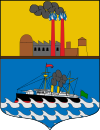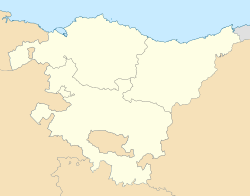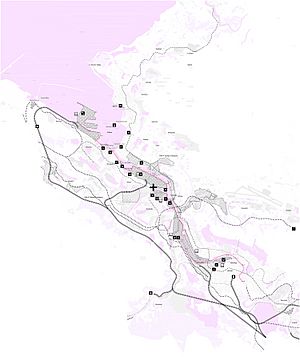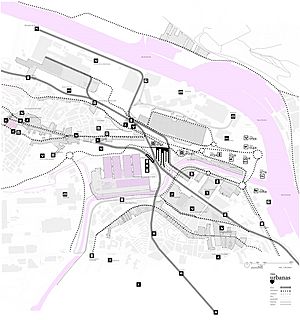Sestao facts for kids
Quick facts for kids
Sestao
|
|||
|---|---|---|---|
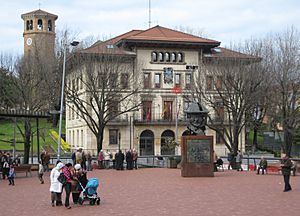
Town Hall
|
|||
|
|||
| Country | |||
| Autonomous community | |||
| Province | Biscay | ||
| Comarca | Greater Bilbao | ||
| Segregated | 1805 | ||
| Area | |||
| • Total | 3.49 km2 (1.35 sq mi) | ||
| Elevation | 67,62 m (22,185 ft) | ||
| Population
(2018)
|
|||
| • Total | 27,445 | ||
| • Density | 7,864/km2 (20,367/sq mi) | ||
| Demonym(s) | sestaotarra | ||
| Time zone | UTC+1 (CET) | ||
| • Summer (DST) | UTC+2 (CEST) | ||
| Postal code |
48910
|
||
| Official language(s) | Basque | ||
Sestao is a town and municipality in northern Spain. It is located in the Biscay province, which is part of the Basque Country. Sestao sits on the left bank of the Estuary of Bilbao and is part of Bilbao's larger metropolitan area.
For a long time, Sestao was home to the most important steel industry in Biscay, called Altos Hornos de Vizcaya.
Contents
Neighbourhoods of Sestao
Sestao is divided into 13 smaller areas, or neighbourhoods. These are:
- Kasko (Basque: Gaisko)
- Kueto (Basque: Goitio)
- Galindo (Basque: Gariondo)
- Albiz
- Urbinaga
- Rebonza (Basque: Urrebontza)
- Azeta
- Simondrogas (Basque: Zumarrondoaga)
- Txabarri (Basque: Etxabarri)
- Markonzaga
- Aizpuru
- Los Baños (Basque: Mañueta)
- Las Llanas (Basque: Oyana)
Population Changes in Sestao
Demography is the study of how populations change over time. Here's how Sestao's population has grown and changed through the years:
| Historical population | |||||||||||||||||||||||||||||||||||||||||||||||||||||||||||||
|---|---|---|---|---|---|---|---|---|---|---|---|---|---|---|---|---|---|---|---|---|---|---|---|---|---|---|---|---|---|---|---|---|---|---|---|---|---|---|---|---|---|---|---|---|---|---|---|---|---|---|---|---|---|---|---|---|---|---|---|---|---|
|
|
||||||||||||||||||||||||||||||||||||||||||||||||||||||||||||
Sestao's Transformation
Sestao was once a big industrial area, especially known for its iron industry. However, many of these industries closed down. This change affected the whole estuary of Bilbao.
Over the last 20 years, the city of Bilbao has been working to improve its riverbanks. They are turning old industrial areas into new spaces. Places that used to have shipyards or factories are now becoming walking paths, parks, art galleries, and new neighbourhoods. This transformation helps the city connect better with its river.
From Industry to Modern City
The industrial crisis of the 1980s hit Bilbao hard. Many large factories closed or became more modern. While this was tough, it also gave the city a chance to reclaim valuable land. This land could then be used for new city developments.
The city is now focusing on services, culture, and new types of industries. The riverbanks are a key part of this plan. They are being improved to create a better environment and boost the economy. The estuary acts like a main pathway for the area. However, it also separates the two sides of the river. One side was more industrial, and the other was more residential. Sestao is a key area that helps connect these different parts.
Connecting Sestao to the Region
Even though some parts of Sestao might seem a bit separate, the town is well-connected. Thanks to the Urbinaga station, Sestao is part of the Metro Bilbao network. This connects Sestao to Bilbao and other areas on both sides of the river. This connection is very important for the people living in "La Punta," a specific area of Sestao.
Urban Development Challenges
Sestao's growth has been limited because there isn't much empty land to build on. It's also surrounded by natural and man-made barriers. This has led to a very crowded town with only small open spaces. Historically, the town grew because of industry, not the other way around. This means Sestao was built mainly because heavy industries set up there.
Industrial areas took up the best spots, especially along the estuary. Less desirable areas, higher up, were used for workers' homes.
Restoring Nature in Industrial Areas
There's a plan to help nature recover in the old industrial areas near the Galindo River estuary. This involves planting plants that can naturally clean up contaminated soil and water. Instead of completely changing the landscape, the idea is to work with the new natural balance of these industrial areas. This approach combines urban development with nature. It also helps the city adapt to the river's changing ecosystem.
Since industries first appeared in 1875, the entire estuary became a major center for heavy industries in Spain. Sestao, in particular, developed into the country's largest industrial base.
You can find more images and information at http://visibleearth.nasa.gov .
Future Plans for Sestao
The city has several ideas for how Sestao will develop in the future:
Public Spaces and Connections
- Public Spaces: Sestao will likely create more small public spaces. These places will offer residents spots to relax, meet others, and connect different parts of the town.
- River Connections: There are plans to improve connections between both sides of the river.
- Water Activities: New programs and facilities will be added that relate to the estuary and water activities, like those for the Kaiku drifters (a local rowing club).
Views and Transport
- Viewpoints: An old convent might be restored to become a viewpoint. From there, you could see the interesting mix of industrial cranes and historic mansions.
- Tram System: The tram system will be connected to Bilbao and the right bank of the river, making travel easier.
Revitalizing Old Structures
- Building Rehabilitation: Some old industrial buildings that are in good condition will be renovated. They will be used for public activities, keeping the look of the industrial structures like jetties, cranes, and pipes.
- Housing and Social Facilities: New homes and social facilities will be built to help the community.
Famous People from Sestao
Many notable people have come from Sestao, including:
- Félix Ayo, a famous violinist
- Vicente Uribe, who was a Minister in the Government of Spain
- Rosa Lavín, a businesswoman
- Josu Calvo, an astrophysicist (someone who studies space and stars)
- Unai Núñez, a professional footballer
- Araceli Sánchez Urquijo (1920–2010), one of the "Children of Russia" who were evacuated during the Spanish Civil War. She was also the first woman to work as a civil engineer in Spain.
- Santiago Urquiaga, another professional footballer
See also
 In Spanish: Sestao para niños
In Spanish: Sestao para niños



